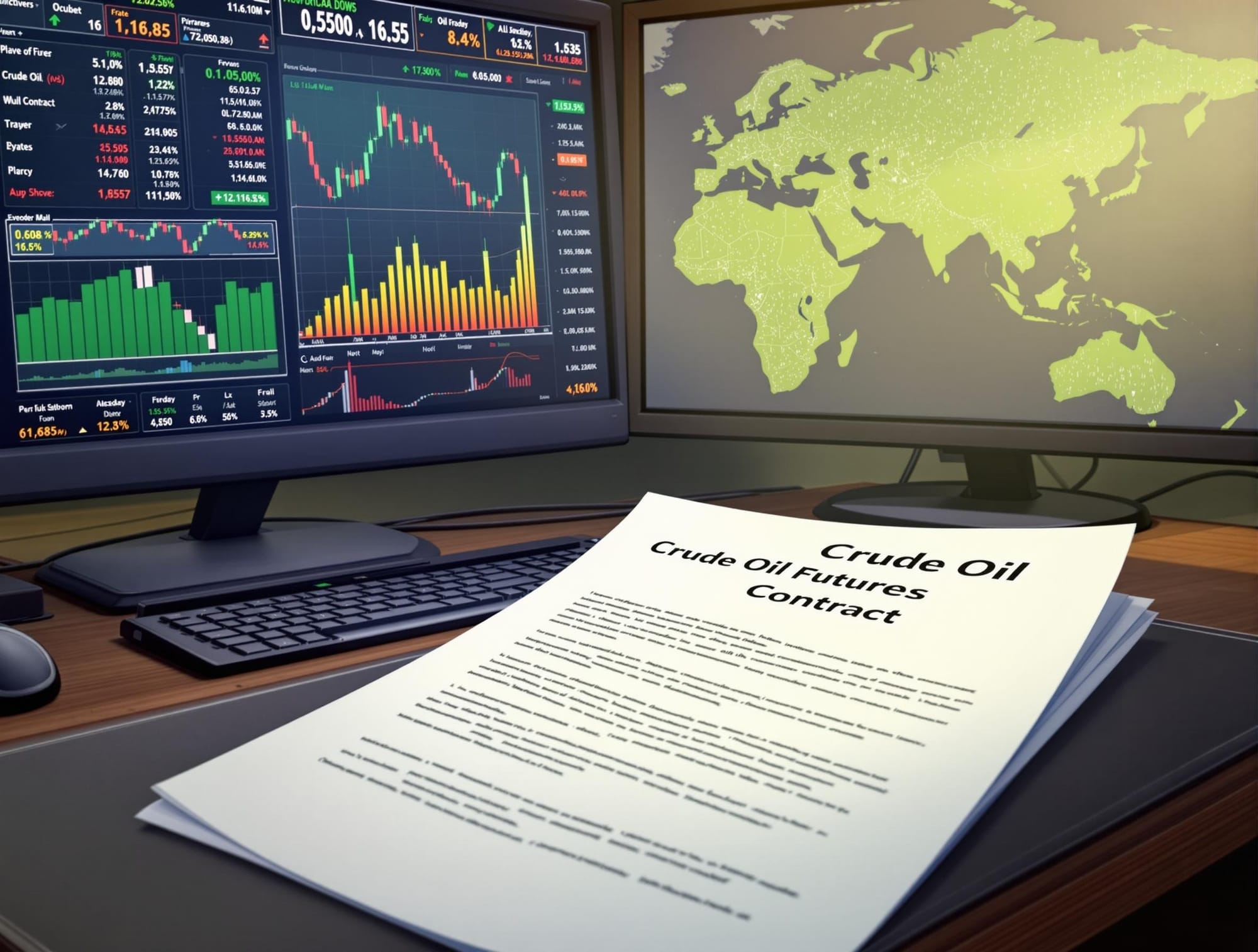How to Trade Crude Oil Futures for Beginners

What Are Crude Oil Futures and How Do They Work?
Crude oil futures are standardized legal agreements to buy or sell a specific quantity of crude oil at a pre-set price on a particular date in the future. These contracts allow traders to speculate on oil price movements without owning physical barrels of oil. Typically traded on regulated exchanges, a crude oil future contract gives buyers and sellers a way to hedge against price changes or to generate profits from market fluctuations.
Understanding how to trade oil futures means knowing that you’re participating in a global marketplace driven by geopolitical events, supply disruptions, and demand surges. Are you prepared to manage these factors and trade oil effectively? Before placing your first order, it’s important to know the specifics of the contract and where trading takes place.
Breaking Down the Crude Oil Future Contract
A crude oil future contract usually represents 1,000 barrels of crude oil, with standardized terms regarding quantity, quality, and delivery date. The two main benchmarks are West Texas Intermediate (WTI) and Brent crude, each setting the standard for oil pricing in the US and globally. These contracts use codes—like CL for WTI and BRN for Brent—along with the contract month and year.
Trading crude oil futures provides price discovery and risk management for oil producers, refiners, and speculators. Knowing the symbols and contract details helps traders avoid costly mistakes, such as trading the wrong month or contract type. Could you confidently choose the right contract for your goals?
Popular Exchanges for Oil Trading
Oil futures contracts are most commonly traded on major exchanges like the New York Mercantile Exchange (NYMEX) and the Intercontinental Exchange (ICE). NYMEX lists WTI, while ICE features Brent, each with robust trading volumes and transparent pricing. These oil exchanges provide the infrastructure and regulation needed to ensure fair trading and settlement.
Understanding where you can trade oil futures is key to getting started. Many platforms, including those recommended by Funded Futures Network, give access to these exchanges for both retail and institutional traders. Have you explored which exchange and platform align best with your trading objectives?

Why Trade Oil? The Benefits of Crude Oil Futures
Trading crude oil futures offers unique advantages for those interested in market speculation and portfolio diversification. These contracts deliver access to one of the world’s most important commodities, enabling you to trade oil in environments of both bull and bear markets. By leveraging the features of futures, traders can potentially profit from price swings, hedge positions, or simply diversify exposure.
What makes oil futures appealing in a crowded market? Two key qualities stand out: high volatility and exceptional liquidity.
Volatility and Opportunity
Crude oil is known for its price swings, which can be triggered by geopolitical tensions, supply disruptions, or economic news. This volatility creates frequent trading opportunities, as prices can move significantly in short periods. For traders who know how to trade oil, this means the potential for both rapid gains and losses.
Are you equipped to handle the emotional highs and lows that come with volatile markets? Developing effective futures trading strategies is crucial for harnessing these opportunities without falling into impulsive decision-making.
High Liquidity and Tight Spreads
Another benefit is the high liquidity in crude oil futures markets, meaning you can enter and exit positions with minimal slippage. Heavy trading volumes attract many participants, from speculators to commercial users, resulting in tight bid-ask spreads. This environment benefits day traders, scalpers, and swing traders alike.
Why is liquidity so important? Tight spreads help keep costs low, making it easier to manage short-term trades and execute large orders efficiently. Platforms like Funded Futures Network help traders access these markets with competitive transaction terms.
How to Trade Crude Oil Futures: Step-by-Step for Beginners
Starting with how to trade crude oil futures may seem daunting, but breaking it down into manageable steps can simplify things. You need to open an account, understand contract details, and grasp basic risk management techniques before making your first trade.
Here’s a straightforward approach for beginners looking to trade oil:
Set Up a Futures Trading Account
First, choose a reliable broker or trading platform that offers access to oil exchanges like NYMEX and ICE. Check the platform’s fees, margin requirements, and supported markets—information that’s often easy to find on platform comparison pages like Funded Futures Network’s preferred platforms.
You'll need to provide identification, fund your account, and possibly complete a suitability assessment. Many brokers also offer demo accounts, which are a great way to practice trading crude oil futures without risking real money. Have you explored the benefits and risks of each platform before choosing one?
Learn the Symbols and Contract Specs
Every oil futures contract has a unique symbol and contract specification. For instance, WTI crude oil futures on NYMEX use the symbol CL, covering 1,000 barrels per contract, with trading quoted in US dollars per barrel. Brent contracts have different symbols and specs, so double-check before placing a trade.
Understanding these specs is essential so you know exactly what you’re buying or selling. Overlooking these details can result in trading the wrong contract or mismanaging your trade size. Would you recognize the difference between micro and standard contracts at a glance?
Understand Margin and Leverage
Trading oil futures contracts involves margin and leverage: you only need to put up a fraction of the contract’s total value to control a much larger position. Margin requirements vary by broker and market volatility, so be sure to check these details through your account or broker’s official site.
Leverage increases the potential profit but also heightens risk, which makes understanding margin rules essential. Are you aware of how fast leveraged positions can change your account balance, both positively and negatively? Explore the rules set by your trading network to avoid surprises.

Key Factors That Drive Crude Oil Prices
Crude oil prices are influenced by a range of dynamic factors. Knowing how to trade oil means staying informed about what moves the markets on a daily, weekly, and long-term basis.
Supply and Demand Dynamics
Just like any commodity, oil prices depend on supply and demand. Changes in global production, coordinated by organizations such as OPEC, or disruptions due to natural disasters, wars, or sanctions, can quickly move prices.
On the flip side, rising demand from emerging markets or seasonal variations—like increased travel in summer—often send prices higher. Is your trading strategy flexible enough to respond when either side of the equation shifts suddenly?
U.S. Inventories and Economic Reports
Weekly reports from sources like the U.S. Energy Information Administration (EIA) provide updates on oil inventories, which can spark sharp market moves. A surprise build or draw in stocks often means big price shifts, rewarding traders who can react to new information fast.
Major economic data, such as employment numbers or GDP growth, also affect demand expectations. Do you have reliable news sources or data feeds that help you anticipate these critical moments? For deeper analysis, websites like OilPrice.com often provide up-to-date reports and context.
How to Trade Oil Futures Safely with Risk Management
Risk management is a cornerstone of successful trading, especially in fast-moving markets like crude oil. Recognizing and controlling risks makes the difference between lasting success and costly mistakes.
Set Your Risk per Trade
Professional traders typically risk only a small percentage of their account on any single trade, often 1-2% at most. Decide your risk limit before entering a position and stick to it, no matter what the market does. This reduces the chance of big losses during losing streaks—a key factor for long-term survival.
How much are you willing to lose on a single trade, and do you consistently follow those limits?
Use Stop-Loss and Take-Profit Targets
Setting stop-loss orders means your trades will automatically close if the price moves against you by a certain amount. Take-profit targets do the same, locking in profits when prices reach your chosen goal. Both tools prevent emotional decision-making and help automate risk control.
Do you always plan your exit before you enter a trade? Using stops and limits is crucial in keeping risk manageable amid the volatility of trading crude oil futures.
Best Futures Trading Strategies for Crude Oil
Having a clear plan is essential if you want to trade oil successfully. Effective futures trading strategies help you make objective decisions, rather than reacting emotionally to the ups and downs of the market. Mastering a few reliable futures trading strategies is essential when learning how to trade crude oil futures. The strategies you choose will depend on your trading goals, time commitment, and risk tolerance. Some traders focus on quick profits from small price moves, while others prefer to capture larger trends over days or weeks. Understanding how to blend approaches—and which technical tools work best—will help you trade oil with greater confidence, whether you’re a beginner or looking to add oil to a multi-asset portfolio.
Scalping, Day Trading, and Swing Trading
Scalping crude oil futures involves making numerous trades throughout the day, each targeting tiny profits on quick price changes. This method requires strong discipline, fast reactions, and real-time news updates because sudden volatility is common in the oil market. Day trading is a bit less hectic, aiming to capture price movements during a single session, with traders opening and closing positions before the market closes. Swing trading, in contrast, lets traders hold oil futures contracts for several days, capitalizing on medium-term trends influenced by supply reports or economic events.
Each approach offers different risk and reward profiles. Scalping and day trading provide frequent opportunities but require more time and attention, while swing trading allows you to take advantage of bigger moves with less screen time. Which style fits your personality and schedule best—and can you maintain discipline under pressure? Platforms such as Funded Futures Network can help you practice these methods in a risk-controlled environment.
Technical Tools That Work Well with Oil
Technical analysis can be especially effective when trading crude oil futures. Popular tools include moving averages to spot trends, Relative Strength Index (RSI) for overbought or oversold conditions, and Bollinger Bands to measure volatility. Many traders also use support and resistance zones identified on hourly or daily charts to determine entry and exit points, making it easier to define stop-loss and take-profit levels.
Candlestick patterns are another favorite, offering visual clues about potential reversals or trend continuations. Many find combining technical indicators with economic data releases—like inventory reports—makes their strategies even more reliable. Have you considered which tools align with your trading style, and have you tested them extensively in a demo environment? Many charting platforms and brokerages offer integrated research tools, and sites like Investing.com can supplement your analysis.

How to Invest in Oil Without Trading Full Contracts
For those unsure about trading a full crude oil future contract or for anyone with limited capital, there are alternative ways to gain exposure to this dynamic market. Not everyone is comfortable with the size or margin requirements of standard contracts, but smaller products and related investments can still offer substantial opportunities. Understanding these options allows you to trade oil futures or invest in oil while managing your risk and commitment level.
Micro Crude Oil Futures
Micro crude oil futures are scaled-down versions of standard contracts, typically representing one-tenth the size, which makes them more accessible for beginners or those trading smaller accounts. The lower margin requirement lets you test futures trading strategies with less capital at risk, while still enjoying the liquidity and transparency of the main exchanges.
Platforms such as Funded Futures Network support micro contracts, which means you can start small while learning how to trade oil with real stakes. Have you calculated how much risk you can manage per trade, and could micros help you build trading confidence without overexposure? Micro contracts trade just like the standard versions, so you still get exposure to the same market movements.
Other Ways to Get Exposure
If direct futures trading isn’t right for you, consider exchange-traded funds (ETFs) and exchange-traded notes (ETNs) that track crude oil prices, like USO or BNO. These trade on stock exchanges and require no special futures account—just a standard brokerage setup. Other options include commodity-focused mutual funds, oil company stocks, or even investing in energy sector indices.
Some platforms provide access to oil contracts through contracts for difference (CFDs) or similar derivatives, although these come with their own risks and are not always available in every country. Which method best matches your risk profile, investment goals, and available capital? It's always wise to research alternatives before fully committing to the futures route.
Final Thoughts on Trading Crude Oil Futures
Learning how to trade crude oil futures opens doors for active traders and investors alike. Oil’s volatility, liquidity, and global importance make it a favorite among those looking for dynamic opportunities. However, success hinges on education—knowing contract specs, risk management, economic drivers, and reliable strategies. Beginners should start small, consider micro contracts or alternative exposures, and utilize available resources such as Funded Futures Network.
Oil trading rewards preparation and discipline. Are you ready to continually learn, adapt your strategies, and manage your risk as markets change? Joining a network of traders or a trustworthy brokerage is a great place to start—there’s always more to explore.
FAQs about How to Trade Crude Oil Futures
What’s the minimum amount to start trading oil futures?
The minimum amount depends on the contract type and the broker’s margin requirements. Standard WTI crude oil futures often require several thousand dollars in margin, but micro contracts can be traded with as little as a few hundred dollars. Always check with your broker and consider additional funds for managing potential losses. Funded trading accounts may help you access the markets with even fewer upfront costs.
How do oil futures contracts expire, and what happens if I hold till expiration?
Oil futures contracts have set expiration dates each month. If you hold a crude oil future contract until expiration, you could be obligated to accept (or deliver) physical barrels of oil in a specified delivery location. Most retail traders close or "roll" their positions before expiry to avoid this, as physical settlement is generally impractical. Be sure to understand your broker’s expiration process—details that are available in Funded Futures Network's rules.
Is crude oil good for day trading or swing trading?
Yes, crude oil’s frequent price moves and high liquidity make it well-suited to both day trading and swing trading. Day traders capitalize on intraday price swings driven by news or economic releases, while swing traders hold positions for days to profit from broader trends. Your choice depends on your time, risk tolerance, and strategy discipline. Many traders use a blend to diversify their approaches and respond to changing conditions.
Can I trade oil futures with a funded account?
Absolutely—many firms and networks, including Funded Futures Network, offer funded trading programs where qualified traders can access capital and trade oil futures without depositing the full margin themselves. These programs set rules for risk and performance but can reduce barriers for aspiring traders. Is a funded account right for your style and goals? Always review the requirements and available platforms before applying.
What’s the difference between WTI and Brent crude futures?
WTI (West Texas Intermediate) and Brent are the two main global benchmarks for crude oil future contracts. WTI is sourced from the US and traded on NYMEX, while Brent comes from the North Sea and is listed on ICE. They usually trade at different prices due to factors like production costs, delivery locations, and diverse supply-demand influences. Understanding these differences helps traders select which product suits their preferred trading hours and market influences. For additional perspective, resources such as Platts.com analyze these benchmarks in real-time.



